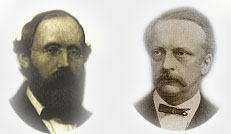

Riemann and Helmholtz

Riemann (1826-1866) / Helmholtz (1821-1897)
Riemann and Helmholtz
Helmholtz, in his paper "On the Facts underlying Geometry" (1868b), explains where he differs from Riemann's view on the foundations of geometry.
Riemann explains that a manifold is to be regarded as n-fold extended when in it the specified individual (the place) can be specified through the specification of n variable magnitudes (coordinates), and he adds the further demand that every line, independent of place and orientation, should be comparable in length with every other. Having done that, he is faced with the problem of determining how the element of length of a line is dependent upon the corresponding differentials of the coordinates. This he does by means of a hypothesis, setting the element of length of the line equal to the square root of a homogeneous second degree function of the differentials of the coordinates. His foundation for this hypothesis is its being the simplest one corresponding to the conditions of the problem. ...
My own investigation differs from Riemann's in the following respect. I looked more closely at this finally introduced restriction, which distinguishes actual space from other severally extended manifolds, and namely at its influence on giving a foundation for the proposition upon which the whole investigation hinges, according to which the square of the line element is a homogeneous second degree function of the differentials of the coordinates. It can be shown, that if one rather adheres from the outset to the demand that figures fixed in themselves should have unconditionally free mobility, without distortion, in all parts of space, then Riemann's initial hypothesis is derivable as a consequence of much less restricted assumptions.
My starting point was that the primary measurement of space is entirely based upon the observation of congruence; ... (Cohen and Elkana 1977, 40-41)
Now, I presume the reader is already familiar with "the problem of determining how the element of length of a line is dependent upon the corresponding differentials of the coordinates", mentioned by Helmholtz (in the first paragraph above; see Gauss' Theory of Curved Surface). The problem boils down to choosing a metric tensor, usually symbolized by g with two subscripts (see Einstein's, Reichenbach's, Gruembaum's, or Sklar's papers and books); if we have a metric tensor, geometry is completely determined. Riemann, as a mathematician, chose a more general approach; but Helmholtz, primarily interested in the epistemology of physical geometry, starts from the notion of congruence in terms of rigid rods, claiming that this notion should be indispensable for any attempt to determine the geometry of our physical space.
Helmholtz's "hypotheses" are, in brief, specified as follows:
I. Space of n dimensions is an n-fold extended manifold.
II. The existence of mobile but rigid bodies, or point systems, is presupposed, such as is needed to enable the comparison of spatial magnitudes by congruence.
III. Completely free mobility of fixed bodies is presupposed.
IV. ...two congruent bodies are also still congruent after one of them has undergone a complete rotation about any axis of rotation. (Cohen & Elkana 1977, 41-44)
Helmholtz shows that if any geometry satisfies these four conditions, it also satisfies Riemann's requirements.
References
Cohen, Robert S. and Elkana, Yehuda, eds. (1977) Hermann Helmholtz, Epistemological Writings, Reidel.
Helmholtz, Hermann (1868a) "On the Origin and Significance of the Axioms of Geometry" in Cohen and Elkana 1977, 1-38.
Helmholtz, Hermann (1868b) "On the Facts underlying Geometry" in Cohen and Elkana 1977, 39-71.
Riemann, Bernhard (1854) "On the Hypothesis which lie at the Foundations of Geometry"; Japanese translation by K. Yano, Kyouritsu, 1971. (現代数学の系譜10)
Last modified March 31, 2003. (c) Soshichi Uchii